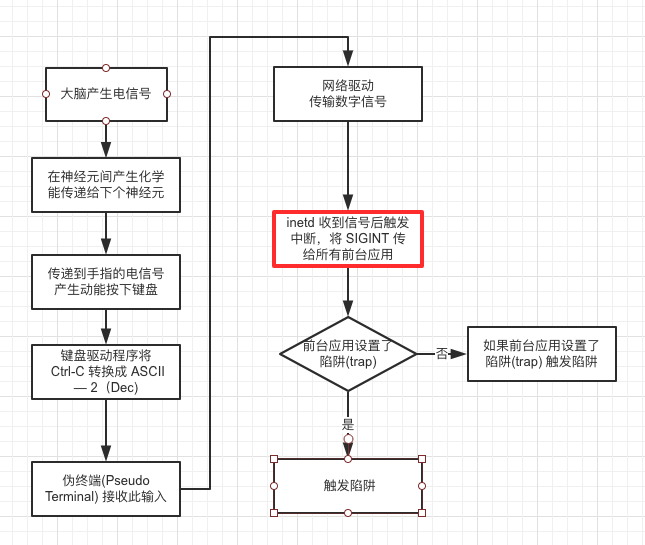目录
- 1 背景姿势
- 2 前戏
- 3 正餐
- 4 systemctl stop docker
- 5 demo
1 背景姿势
驱动
驱动程序全称设备驱动程序,是添加到操作系统中的特殊程序,其中包含有关硬件设备的信息。此信息能够使计算机与相应的设备进行通信。
中断
触发系统将运行时间由用户态程序交还给内核态的一种方式。
终端
终端
伪终端(pseudo terminal) --> /dev/pts/8
会话
信号
发送给程序的来表示有重要事件发生的软件中断。
系统收到信号后,会把 CPU 时间交由内核态,然后再进行退出程序,挂起,恢复,或自定义操作。
常见信号
| 信号 | 按键 | 意义 |
|---|---|---|
| SIGINT | Ctrl-C | 退出当前 session 所有前台进程 |
| SIGTSTP | Ctrl-Z | 挂起前台进程 |
| SIGTERM | 优雅杀掉指定进程,可被阻塞 | |
| SIGKILL | 强制杀掉指定进程 | |
| Ctrl-D | 不是 signal, write EOF to input |
发送信号
kill -SIG pid自定义信号
trap "echo 'signal SIGINT received'" SIGINT延伸 Tips 1:
nohup 的由来:
nohup python3 manage.py runserver &当终端中断时(拔网线,wifi 断网等),相关驱动程序会给当前会话
(session, 简单来说一个 login shell 就是一次会话)
中所有程序(前台和后台)发送 hang up(HUP) 信号,使程序退出。
延伸 Tips 2:
Ctrl- signal SIGQUIT
Ctrl+J实际上是一个换行符。
按下Ctrl+I与按下Tab键的效果相同。
Ctrl+[与ESC相同。
Ctrl+H代替BackSpace键。
鼠标右键快捷键:VK_APPS (93)
2 前戏 - linux 进程生命周期
3 正餐
4 systemctl stop docker
案发现场
耗子叔的一篇博客
systemd 是个啥么玩意
系统的 init 程序,进程调度管理程序,id 为 1,所有进程的爹
systemctl 是systemd 的 shell interface,常见的操作: systemctl start|stop|status|reload
systemctl stop
docker service 的行为定义在/usr/lib/systemd/system/docker.service
systemd stop 的 man: the process is terminated by sending the signal specified in KillSignal=(SIGTERM) when service stop is requested.
dockerd trap
systemctl stop dockerd 执行后会给 dockerd 发送 SIGTERM 信号,dockerd 捕获到这个信号后,会去调用 cleanup 清理程序清理掉它下面的容器,同时计数器加一,当收到3次 SIGTERM 或 SIGINT(比如按下 ctrl-c)后,会出发 “force exit without cleanup”,强行退出 dockerd ,就会导致 dockerd 退出,但容器不退出,因而容器占用但资源(ip 地址等)不会被释放。此外,如果 kill -9,会发送 SIGKILL,强行杀掉 dockerd,也是不会清除容器但。所以慎用 ctrl-c ,慎用 kill -9 啊!!
// * If SIGINT or SIGTERM are received, `cleanup` is called, then the process is terminated.
// * If SIGINT or SIGTERM are received 3 times before cleanup is complete, then cleanup is
// skipped and the process is terminated immediately (allows force quit of stuck daemon)
// * A SIGQUIT always causes an exit without cleanup, with a goroutine dump preceding exit.
c := make(chan os.Signal, 1)
// we will handle INT, TERM, QUIT, SIGPIPE here
signals := []os.Signal{os.Interrupt, syscall.SIGTERM, syscall.SIGQUIT, syscall.SIGPIPE}
gosignal.Notify(c, signals...)
go func() {
interruptCount := uint32(0)
for sig := range c {
if sig == syscall.SIGPIPE {
continue
}
go func(sig os.Signal) {
logger.Info(fmt.Sprintf("Processing signal '%v'", sig))
switch sig {
case os.Interrupt, syscall.SIGTERM:
if atomic.LoadUint32(&interruptCount) < 3 {
// Initiate the cleanup only once
if atomic.AddUint32(&interruptCount, 1) == 1 {
// Call the provided cleanup handler
cleanup()
os.Exit(0)
} else {
return
}
} else {
// 3 SIGTERM/INT signals received; force exit without cleanup
logger.Info("Forcing docker daemon shutdown without cleanup; 3 interrupts received")
}
case syscall.SIGQUIT:
DumpStacks("")
logger.Info("Forcing docker daemon shutdown without cleanup on SIGQUIT")
}code is here.
延伸 Tips3:
如何删除进程和子进程:
进程和子进程在同一组中,可根据 PGID kill 掉一组进程
kill -- -$PGID Kill using the default signal (TERM = 15)
kill -9 -$PGID Kill using the KILL signal (9)5 I want more
《Unix 环境高级编程》
Learn C!





**粗体** _斜体_ [链接](http://example.com) `代码` - 列表 > 引用。你还可以使用@来通知其他用户。